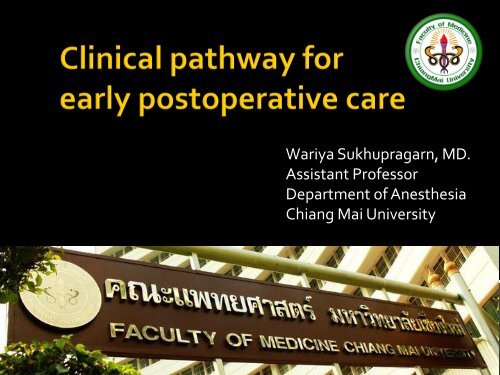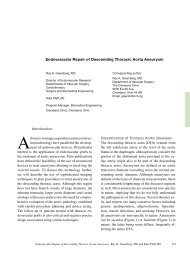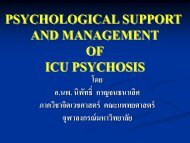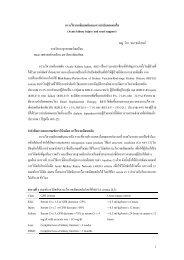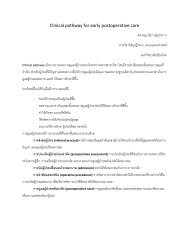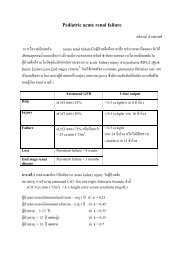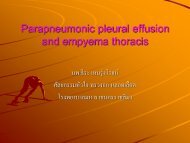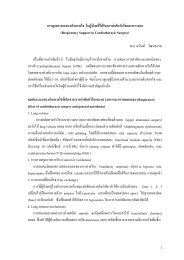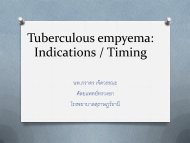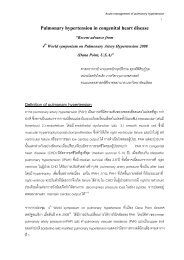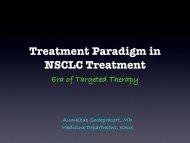Clinical pathway for early postoperative care
Clinical pathway for early postoperative care
Clinical pathway for early postoperative care
You also want an ePaper? Increase the reach of your titles
YUMPU automatically turns print PDFs into web optimized ePapers that Google loves.
Wariya Sukhupragarn, MD.Assistant ProfessorDepartment of AnesthesiaChiang Mai University
• <strong>Clinical</strong> <strong>pathway</strong>s are structuredmultidisciplinary <strong>care</strong> plans used by healthservices to detail essential steps in the <strong>care</strong> ofpatients with a specific clinical problem.
• Improve patient flow• Reduce variability in process• Increase activity• Make beat use of capacity (frees up resources<strong>for</strong> inpatient operations and emergency <strong>care</strong>)• Treat patients faster with shorter waitingtimeshttp://www.institute.nhs.uk
• Referral process• Pre-operative assessment• Admission• Operative procedures• Post operative <strong>care</strong>
• Early <strong>postoperative</strong> tracheal extubation• Early discharge from the ICU• Shorter overall hospital length of stay• Decreased resource utilization• Possible reduction of hospitalization costs
• Adequate mental status• Strength• Oxygenation• Normal body temperature• Lack of mediastinal bleeding
• Patient background (age, sex)• Type of operation• Indications <strong>for</strong> operation• Pre-operative cath report• Success of operation• CPB time and aortic cross-clamp time
• Ease of separation from CPB ( dysrhythmias,need <strong>for</strong> inotropes, pacing, etc).• Difficulty coming off pump may implyproblems with myocardial preservation orwith the revascularization.• Current inotropes, vasopressors, or antihypertensives(if any)
• Need <strong>for</strong> cardiac pacing• Use of Intra-aortic balloon pump (IABP),ventricular assist devices (VAD), or nitricoxide (NO).• Significant bleeding
• Other significant co morbidity. (carotid arterydisease, COPD, asthma, diabetes, renalfailure, hepatic failure, etc.)• Pre-operative medications• Allergies
• Assure that the endotracheal tube is in properposition and the patient has equal air entrybilaterally.• Verify that the patient's oxygen saturation isadequate. Check the ABG results as soon asthey are available.• Verify correct ventilator settings.
• Check the initial hemodynamic readings (HR, BP,cardiac output and index, CVP, PCWP) anddetermine what vasoactive infusions the patientis on and at what rates.• Check the patient's heart rhythm. Verifypacemaker settings if the patient is connected toone.• Check the chest and mediastinal drainage sumpsto ensure they are patent and that the patient isnot bleeding excessively.
• Examine heart sounds. Listen <strong>for</strong> murmursparticularly if the patient has had valvesurgery.• Check all peripheral pulses. Do repeatedassessments if there is concern <strong>for</strong> acute limbischemia or if the patient has a femoralarterial line or IABP in place.
• Examine the abdomen.• Check pupillary reflexes. Do a more completeneurologic exam when the patient begins toawaken from GA.
Raspunde: Seful Serviciului Rutier-Cu ocazia instructajelor zilnice, la intrarea in serviciu, ofiterii sefi deschimb vor prelucra ordinele si dispozitiile de linie incidenteacţiunilor dispuseTermen: zilnicExecuta: ofiterii şefi de schimbRăspunde: Seful Serviciului Rutier, şeful B.D.E.N.SEFUL SERVICIULUI RUTIERComisar-şef de poliţieHUŢANU IOANPunctul 3MINISTERUL AFACERILORI INTERNE AGENŢIA NAŢIONALĂ ANTIDROGCENTRUL PREVENIRE, EVALUARE ŞI CONSILIERE ANTIDROG COVASNA1. Consideraţii generaleRAPORTPrivind activităţile desfăşurate pe parcursul anului 2012Con<strong>for</strong>m H.G. nr. 461 din 2011 privind înfiinţarea şi funcţionarea Agenţiei Naţionale Antidrog,misiunea Agenţiei Naţionale Antidrog este de a elabora, coordona, evalua şi monitoriza, la nivel naţional,politicile în domeniul prevenirii şi combaterii traficului şi consumului ilicit de droguri, misiune <strong>care</strong> la nivelteritorial se materializează prin intermediul Centrelor de Prevenire, Evaluare şi Consiliere Antidrog.Pentru asigurarea unei abordări unitare cu privire la fenomenul drogurilor, activităţile de reducere acererii şi ofertei de droguri trebuie coordonate şi integrate în programe şi instrumente practice, curespectarea autonomei funcţionale, prin dezvoltarea, permanent, de instrumente interinstituţionale <strong>care</strong> săpermită reacţia în timp operativ şi eficient pentru atingerea obiectivelor propuse în strategia naţională şiimplicit locală.Ca şi structură teritorială a Agenţiei Naţionale Antidrog, Centrul de Prevenire, Evaluare şi ConsiliereAntidrog Covasna şi-a însuşit rolul de coordonator local în apli<strong>care</strong>a prevederilor Planului de acţiune pentruimplementarea Strategiei Naţionale Antidrog. Date fiind concluziile diagnozei locale referitoare laconsumul de droguri legale şi ilegale, Centrul de Prevenire Evaluare şi Consiliere Antidrog Covasna, adezvoltat şi diversificat activităţi de prevenire primară şi secundară a consumului de droguri în sistemulşcolar, în mediul familial şi în comunitate.19
http://www.med-ed.virginia.edu/courses/rad/chest/PCWP1.htm
http://www.med-ed.virginia.edu/courses/rad/chest/PCWP2.htm
http://www.umdnj.edu/rwjlbweb/Basicrad/FILES/SEFRM095.HTM
http://www.medscape.com/viewarticle/519318_3
• Hemoglobin• Coagulation parameters (PLT, PT, PTT, INR,ACT)• Potassium, magnesium• Glucose - tight glycemic control <strong>postoperative</strong>lyreduces morbidity.
• CPB is usually accompanied by hypothermiato < 32 C.• Patients are usually warmed to at least 34 Cbe<strong>for</strong>e transfer to the ICU.
• Predisposes to ventricular dysrhythmias and lowersVF threshold• Increases SVR; increases afterload and myocardialworkload• Patient shivering causes increased peripheral O2consumption• Decreases CO2 production; a patient who has arespiratory alkalosis (low PCO2) on initial ABG usuallywill increase their PCO2 with rewarming• Coagulopathy; impairs platelet function and thecoagulation cascade. Rewarming is an important partof the treatment of a bleeding patient.
• Medical bleeding• Surgical bleeding
• Persistent bleeding in the absence of a specifichaemostatic defect.• Sudden onset of fresh, rapid bleeding; especiallyif associated with a preceding sudden increase inBP.• > 500 cc of bleeding in the first post-op hour.• > 400 cc/hr x 2 hours.• > 300 cc/hr x 3 hours• > 200 cc/hr x 4 hours
• Residual heparin effect• Qualitative platelet defects.• Quantitative platelet defects.• Clotting factor deficits.• Fibrinogenolysis; plasminogen activationduring CPB.
• Correct hypothermia.• Control BP if elevated.• Protamine 25 - 50 mg iv if ACT elevated.
• Desmopressin (Minirin, DDAVP)• Increases plasma levels of factor VIII and vWF• This has been shown to improve platelet functionand decrease active bleeding in uremia orvonWillebrand's disease.• It is given post-cardiac surgery because it is felt itmight improve platelet function although the dataare mixed in this setting.
• Platelet transfusion.• Five units of platelets should raise the plateletcount by 25,000 to 50,000 and will also provideclotting factors equivalent to 1 unit of FFP.• In a patient who is bleeding significantly, the goalis to keep the platelet count greater than 100,000of functional platelets.
• Fresh Frozen Plasma.• Normally 2 to 6 units with each unit 200 to 250 ml.• Giving a total of 20 cc/kg will replace factor levelsto at least 50% of normal if you are starting atlevels of 0.• In a bleeding patient the goal is to return the PTand PTT close to normal values.
• Cryoprecipitate.• Contains fibrinogen, factor VIII, vWF andfactor XIII.• 1 unit is 20 to 25cc.• Usually given pooled as 8 to 10 units <strong>for</strong> suspectedor confirmed hypofibrinogenemia.
• Antifibrinolytic agents.• Episilon-aminocaproic acid (AMICAR), tranexemicacid, or aprotinin.• Inhibit conversion of plasminogen to plasmin thuspreventing activation of fibrinolysis.• Ideally should confirm fibrinolysis be<strong>for</strong>e use (elevated D-dimers, low fibrinogen).• Risk of thrombosis including acute graftthrombosis, DVT, PE.
• Raising the head of the bed or increasing thelevel of PEEP on the ventilator are also usedon occasion.• PRBC; to maintain adequate oxygen deliveryduring the period of significant bleeding.
1. BP = CO x SVR2. CO = HR x SV (stroke volume)3. Stroke volume is determined by preload,contractility, and afterload4. Bradycardias or tachydysrhythmias thatdecrease ventricular filling can decrease C.O.
• Rate• Rhythm• Preload• Afterload• Contractility
1. Adrenergic (catecholamine)• Dobutamine - beta-agonist (ß1 >ß2). Increasescontractility and HR. ß2 effect can sometimesdecrease SVR and BP. ß1 effect can causedysrhythmias.• Epinephrine -alpha and beta agonist (ß > alpha).Increases HR, CO, and SVR.• Dopamine - stimulates dopaminergic, beta, andalpha receptors in dose-dependent fashion.
1. Phosphodiesterase inhibitors• Milrinone increases cardiac output. It alsodecreases Pulmonary Vascular Resistance (PVR)and thus can be useful if pulmonaryhypertension or significant right ventriculardysfunction is a problem.
1. Adrenergic (catecholamine)• Norepinephrine (Levophed) -Strong alphaagonist with beta activity as well. Causesvasoconstriction and thus increases SVR and BP.• Phenylephrine - Pure alpha agonist.2. Peptides• Vasopressin - used <strong>for</strong> hypotension with anormal or high cardiac output and low SVR statethat is refractory to norepinephrine.


